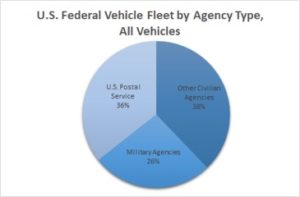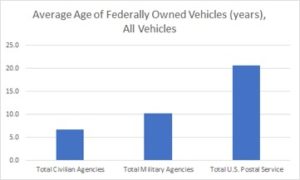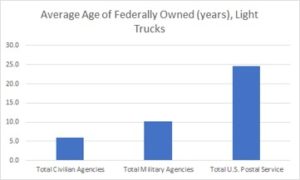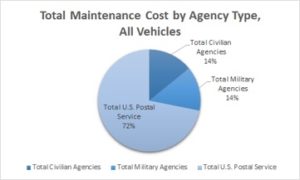Preparing for the Next Generation in Postal Transportation
Change in American infrastructure happens slowly, with progress measured in improvements over decades and generations, not days and months. Part of this is because a large portion of the nation’s infrastructure is owned and managed by the government, which faces constraints that reward slow, low-risk action over entrepreneurial risk-taking with regard to major long-term investments. As the government mail carrier, the United States Postal Service is no different. Its tens of thousands of vehicles are old and in need of replacement, and other trends in the transportation space stand to create new challenges for an agency already well behind on its journey to long-term sustainability in an era of declining mail volumes.
As a government-run transportation agency, the U.S. Postal Service relies on its vehicle fleet to carry out its core mission of delivering mail to every address in the country. While some vehicles used for rural mail delivery are owned by letter carriers, the vast majority of these vehicles are government assets, purchased with government funds and maintained by government employees. These trucks and vans, more than 200,000 in total, account for about one third of all government vehicles—more vehicles than used by the military.
Figure 1: U.S. federal vehicle fleet by agency type

Source: General Services Administration
Figure 2: Average age of federally owned vehicles

Source: General Services Administration
Postal vehicles as a whole have an average age of over 20 years. For light trucks specifically, the type used to deliver mail in most cases, the situation is even more dire. The average age of a USPS light vehicle in 2018 was 24.6 years, fully twice as old as the average light truck owned by the military and 4 times the age of one owned by the collective fleet of civilian agencies.
Figure 3: Average age of federally owned light trucks

Source: General Services Administration
What’s clear from the above figures is that, compared to other vehicles owned and operated by the U.S. government, postal vehicles are further in their lifecycle than vehicles of other agencies. Operating a fleet of aging vehicles poses problems for any government agency. Spare parts get harder to come by as time passes, and finding skilled labor to maintain old, bespoke vehicle types is a challenge, whether you’re the postal service or the military. Maintenance on vehicles owned by the postal service represents a disproportionate share of all government vehicle maintenance costs. In fact, postal vehicle maintenance is the largest single cost item on the federal fleet ledger.
Figure 4: Total vehicle maintenance cost by agency type

Source: General Services Administration, R Street calculations
Beyond ease of maintenance, old vehicles pose a number of other issues, not the least of which is vehicle safety. 34 postal vehicles caught fire in 2019, and a mail carrier in Michigan died in January 2020 after a rear end collision set her mail truck ablaze. Most mail trucks don’t have air conditioning, with a climate control system installed in only 63,000 of the agency’s 230,000 vehicles. Lack of air conditioning was a factor in the heat death of a postal worker, Peggy Frank, in 2018. This comes despite a mandate that all new postal vehicles purchased after 2003 have air conditioning, and any harm that has resulted from its absence can be seen as a consequence of the USPS’s slow action in renewing its fleet.
On a longer timeline, the USPS vehicle fleet, powered by gasoline, also imposes environmental costs. Almost all of the USPS fleet is powered by gasoline and other petroleum products. The total postal gasoline bill constitutes more than half of federal vehicle fuel spending. This has led some lawmakers to propose that new postal vehicles be powered by electricity or using a hybrid electric design. Currently, the USPS operates eight electricity-powered vehicles and another 10 diesel-electric hybrid vehicles. Should the federal government impose new rules on the fuel efficiency of civilian delivery vehicles, a decision to order a new fleet of gasoline-powered mail trucks could give the agency an unfair advantage vis-a-vis private carriers, but only because the government agency would not account for negative externalities its competitors would be forced to internalize. While the decision on which types of vehicles to buy remains in the hands of USPS leaders, they should consider the social costs to the country, as well as the long-term costs to the agency, when making decisions about the fuel source for the next postal fleet.
Figure 5: Number of USPS vehicles by fuel source

Source: General Services Administration
Preparing for the next generation of postal transportation starts by ensuring that any decision on which vehicle to purchase is appropriate not just for the USPS’s immediate needs, but for the full equipment lifecycle of 20 or more years. This goes beyond a decision on which fuel source is to be used, and includes other long-term postal considerations, including whether and how postal vehicles will be used for other non-letter services. Beyond the first-order issues that come with an aging postal vehicle fleet, by primarily making vehicle purchases in large, once-in-a-generation tranches, the agency is slow to take advantage of new technologies and infrastructure that could make it more efficient and improve its financial prospects.
For instance, postal policymakers have long suggested that USPS vehicles could serve as a platform for environmental and traffic data gathering and other “passive” data gathering services that could earn profits for the agency. As early as 2011, Popular Science ran an article highlighting the research of Postal Regulatory Commission chief counsel Michael Ravnitzky into the prospects of such a vehicle-based sensor network.
Beyond new ancillary services, onboard sensors could aid the USPS itself. Traffic sensors in USPS vehicles could also gather data on whether and where roads have enough short-term loading space for postal vehicle parking under live traffic conditions, as well as assess the driving habits of postal employees as they carry out their work. Such data could prove useful should USPS officials and/or legislators choose to formalize the USPS’s exemption from certain traffic laws. With data in hand, USPS officials could request strategic reallocation of street parking for short-term deliveries like mail service. Better, a formalized traffic law exemption combined with onboard sensors would allow the USPS to set data-verified guidelines for USPS driving behavior, allowing it to punish postal workers who routinely drive recklessly or park in unsafe locations such as in front of fire hydrants. On a more mundane level, truck-mounted sensors could generate automatic reports of deteriorated or wrongly-placed mailboxes, avoiding ad-hoc intervention on a property-by-property basis should the postal service or its regulators change rules regarding the mode of mail delivery.
Postal-vehicle-based sensors would also allow the USPS to adapt to other changes happening in the broader American transportation landscape. Since the current generation of postal vehicles entered service, America has seen a boom in the number of toll roads. Some are owned by states, others by private firms and others by public-private partnerships. Similarly, New York City recently implemented the nation’s first urban congestion fee. Historically in America, postal vehicles have been exempted from road tolls, a subsidy from toll road operators to USPS predecessor agencies. But the postal service also has a long history of paying for access to advanced transportation services and infrastructure, including railroads and express mail lines.
Whether the USPS is or should be liable for paying market rates for postal vehicles to use toll roads remains an open question. For longer-distance mail movements, like those between mail processing plants, it’s able to dodge the question through the design of its highway contract route contracts, shifting the decision about whether or not to use particular tolled facilities to contract carriers.
This question gets much more problematic with regard to urban congestion fees. There is little question that postal vehicles, like all other delivery vehicles, contribute to urban congestion. But whether the USPS should be liable to pay these fees is another story. The USPS must, by law, deliver mail to every address, six days per week, every week. But beyond this, the concept of “universal service” in America is poorly defined, and it is unclear if any costs associated with local road access fees would be part of the cost of the USPS universal service obligation, part of USPS overhead or not applicable at all due to the federal universal service obligation overriding local urban congestion fees. The United States is not alone in reckoning with tension between universal postal service and efficient congestion fees—the government of the United Kingdom decided against applying the London congestion fee to its national postal operator, Royal Mail. With the prospect of the proliferation of urban congestion fees within the next USPS vehicle lifecycle, ensuring any new trucks have roadway user fee transponders installed from the outset would limit the need for costly retrofits down the road.
In the end, any transportation changes the USPS must undergo will require spending some amount of capital money. At a self-funding agency that’s already not paying for one type of long-term liability, retiree pension and healthcare costs, the expected source of these funds remains unclear. One option would be for the Treasury to return accumulated USPS retirement funds to the agency, allowing the postal service to dip into its savings to buy equipment. While it could conceivably be done through regulatory fiat, a more complete approach would pair any retirement asset shift with liberalized pension investment rules that would allow the agency to recoup some of the funds with returns on invested capital. This is likely the only option that would preserve the USPS’s status as a truly self-funding agency and would be akin to an individual dipping into their 401(k) to replace the vehicle they drive to work. The downside is that USPS retirement funds are already below projected needs, and buying new vehicles out of accumulated savings would set the agency further back. Another option would be for the federal government to pass a one-off appropriation, buying the agency its new trucks without assuming any other kind of long-term liability for taxpayers. Alternatively, it could buy the new fleet itself, leasing the vehicles to the agency. This method would limit USPS vehicle costs without new agency-derived capital funds, but would create perverse incentives for the USPS to under-maintain its fleet and shunt maintenance risk onto federal taxpayers. This would be akin to how the USPS manages a portion of its real estate portfolio, where the agency leases buildings, but takes responsibility for building maintenance itself. In doing so, the USPS limits the total amount of real estate capital it needs to own, in exchange for some residual authority over postal assets.
All of these options are far from perfect, but at some point, the money will need to be spent. Should the USPS and lawmakers move slowly, missing new profit opportunities and creating inefficiencies in the American shipping market will pale in comparison to the costs of maintaining very old vehicles and the deaths and injuries failing vehicles are sure to bring.







